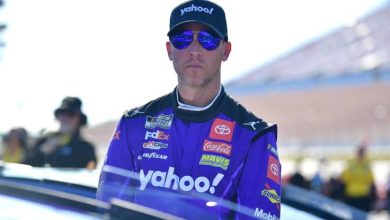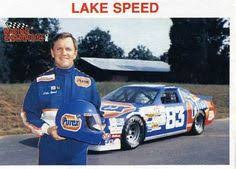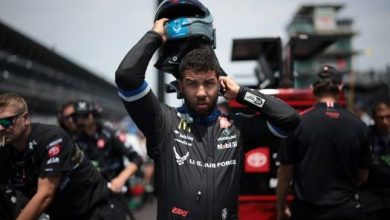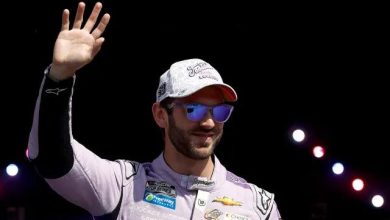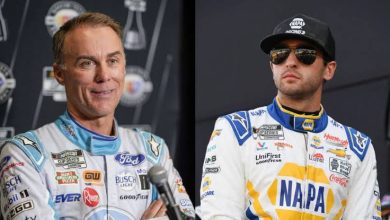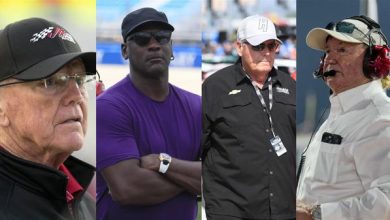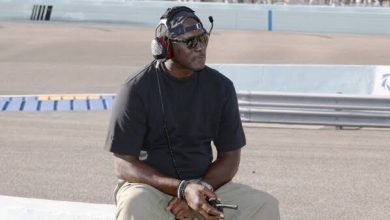BAD NEWS: Denny Hamlin Has Officially announced departing from NASCAR and Reason Why…..

BAD NEWS: Denny Hamlin Has Officially announced departing from NASCAR and Reason Why…..

Many stories like this resurface at these events.
One notable example from this weekend came from the 1995 NASCAR SuperTruck Series race at Martinsville Speedway with Geoff Bodine leading the race trying to fend off Mike Skinner.
Bodine struggled to get through lapped traffic and was held up pretty heavily by Ron Hornaday.
The delay caused Hornaday’s No. 16 Chevrolet allowed Skinner to catch up to Bodine where they both battled it out for the win before crashing together on lap 148. Back then, Bodine pointed fingers at both Skinner and Hornaday, but today, the trio is able to laugh about the incident.
“When we were competitors we didn’t like each other because we had to compete. Now we’re in there having a great time telling stories and just having a good time taking pictures,” Bodine shared.
“So, what NASCAR’s doing with us older guys, these retired guys is great.”
This group is more than just connecting with former competitors and reminiscing about old times – it’s also a chance for these members to show their appreciation for one another.
“It’s super special. I mean, Amber’s group and the NASCAR folks doing this alumni deal is brilliant,” Mike Skinner said while talking to the media outside the NASCAR Alumni Network hospitality tent.
“A lot of times we want to come back to the race track—well, a lot of us still motorcoach. So we want to be able to get a motorhome spot. We want to come and shake hands and see people.
I mean, Richard Petty gave me my first job in NASCAR in 1983. I get to go see him, shake his hand, and, you know, hug his neck. You know, it’s really cool to see people.”
Darlington is the perfect place to gather these legends, for its history and celebration of said history on Throwback Weekend.
Part of that celebration also entails the throwback paint schemes that honor the drivers and their families.
One moment that stood out involved Todd Gilliland’s No. 34 Ford Mustang Dark Horse, which carried a Ray Fox-inspired throwback.
When one of Fox’s daughters saw the car reveal, she knew she had to be at the track – and the Alumni Network helped make that happen.
“She said, I feel like my dad is alive again, seeing his name on that car, and seeing how they’re honored, that honoring them,” Wells explained.
“I think that’s just the way that current NASCAR can connect back to our history and how our sports started and has evolved.”
As the NASCAR Alumni Network continues to grow, Wells is hopeful about its future.
She envisions more at-track events like those at Darlington and Indianapolis Motor Speedway – where during the 20th running of the Brickyard 400, the network helped bring drivers from the inaugural 1994 race to the track.
She’s also working to expand her Rolodex and welcome more back into the sport.
“I’ve been at NASCAR a long time, and this is one of the most rewarding things that I’ve had the opportunity to work on,” She said.
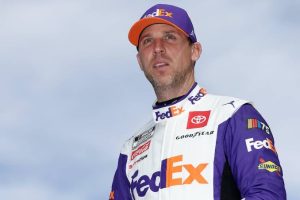
“I want as many people that are interested in being a part of it. I want to find them.
I want to connect with them, and I want to make sure that they know that they’re welcome and that they still have a place here with us.”
A moment like this happened this weekend at Darlington in the Fan Zone when a few alumni attended a gathering called a Tweet-Up, where the fans and drivers were able to interact with one another, allowing them to reconnect with those who cheered them on week after week.
“The drivers are getting as much out of it as the fans are,” Wells said.
“They’re feeding off that energy because our core fans have an experience with Mike Wallace.
They have an experience with Ron Hornaday or Mike Skinner, and they want to tell them about it. And the beautiful thing is these guys want to hear it.”
Geoff Bodine, who was one of the drivers to venture out to the Fan Zone echoed that sentiment.
“We didn’t have the TV and all the coverage like they have today, so we really appreciate what NASCAR’s done is putting us together and showing us to the crowds, getting on stage and introducing us and doing media things and doing autographs…
the generation I came from in racing, we appreciate all of that,” he said.
“Now back then, yeah you’re racing, you’re focused, you’re busy, sometimes drivers didn’t want to sign autographs but today ‘please come here, I want to give you an autograph, come on over here’, we love it!”
The reconnection with fans and the industry is something that was expected for Wells.
However, what came as a pleasant surprise was seeing the fellowship that these drivers have built, all thanks to the environment the NASCAR Alumni Network has helped foster.
“They may have had these adversaries on the racetrack, but for the most part, they’re all in the same place now, right?
They’ve retired, they’ve stepped away from competition, they’ve aged in their lives, and they’re just at a different point in their journey.
And they want to reconnect,” Wells shared.
“They want to say, ‘Hey, do you remember this? Do you remember when
Amber Wells, the Executive Director of the NASCAR Alumni Network, has always had an appreciation for the sport’s history.
With over 25 years in the industry, she has worked closely with, and managed, the NASCAR Hall of Fame for the company, welcoming each Hall of Fame class since its inception.
Throughout her career, Wells has focused on building lasting connections between NASCAR’s living legends, their families, and the community that continues to honor them.
But as she worked to celebrate those cementing their place in the Hall of Fame, one recurring issue kept surfacing – an issue she couldn’t ignore.
“I quickly realized that there was no database, there wasn’t an existing document or a file or a Rolodex, if you want to go back that far, of contact information for these guys,” she explained.
“As we’re going through the Hall of Fame process, and we need to find Cale Yarborough. Well, you make phone calls and send emails and eventually, you get connected with Cale Yarborough.

That missing Rolodex wasn’t just a logistical gap–it symbolized a disconnect between the sport and many of those who helped build it.


